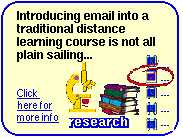New Ways To
Learn
3. A new learning process
Is there a common link between the different experiences
of new ways to learn?
What we see struggling to emerge is a new learning
process that focuses on the individual learning
experience, rather than the group experience of the
conventional classroom.
The classroom: all aboard the school bus
As our diagram shows, the heart of traditional learning
is the classroom, where the teacher attempts to convey his
or her knowledge directly to a group of pupils. When we
think of learning, it is images of the classroom that spring
to mind. In the classroom, the key relationship is the
direct link between teacher and pupil. Any other
relationship - pupil to pupil, or pupil with anyone or
anything outside the classroom - is a distraction, and is
actively discouraged.

Moreover, the teacher drives the process. As when
boarding a bus, the whole class can only go in one direction
and at a common pace. The teacher sets the timetable,
determines the syllabus, the nature, quality and depth of
the content, and steers a common path through the learning
task. The direction and pace is set by the teacher - and the
whole class depends on her or his expertise to get them
through safely andwithout taking a wrong turn.
The new process: learner at the controls
Emerging from the growing use of IT and, especially,
online technology, is a process which works in a different
way. Here there is a much more direct interaction between
learner and learning material. Minute by minute, it is the
learner who controls and drives the process - even if he or
she chooses to spend some time in a classroom or a lecture
hall.
But the learner is not alone. Overall motivation and
guidance are supplied by a dense web of interactions with
learning material, teachers, fellow learners and others.
Potentially this is a much richer, and more flexible,
experience than the classroom. There is much that can go
wrong; but we see evidence that under the right conditions
the process becomes self-correcting and even
self-propagating, creating a sustainable learning
culture. In these circumstances learners and teachers
exchange not only learning content, but knowledge of how to
learn - and how to teach. In this environment, both
motivation and technique rub off. People guide each
other.

The teacher's role
In this new process, teachers are far from redundant. The
teacher develops a new and highly skilled role as guide and
consultant, setting tasks and assisting the learner to
evaluate outcomes. Crucially it is the learner's own
motivation, supported by group interaction and a wide range
of external stimuli, that fuels immediate learning. A key
task, therefore, is to stimulate and maintain that
motivation using all the resources of media and group
support available.
Building on this, an additional role is emerging for
those with teaching skills: to create material that
incorporates this stimulus, motivation and guidance, using
all the facilities of new technology and media production to
go far beyond the traditional textbook. New learning
materials not only provide a much richer interaction: like
sophisticated computer games they can, where appropriate,
record the path each learner takes, report impartially on
progress, and gently or firmly steer learners in useful
directions.
New relationships
A great deal has been written about 'learner centred'
education; but experience suggests a more complex picture.
No-one learns alone; a new web of relationships is
developing in tandem with the new process, and there is
growing evidence that these relationships are a key part of
making the process work.
There are relationships with other learners, with
experts, and with real life sources of information. We even
see a developing role for an online 'audience', which can be
extremely effective in motivating certain types of
activity.
Relationships within the classroom are well defined and
understood; the new process is creating a new set of
relationships, which have yet to be fully mapped. ICT
provides the medium through which many new relationships are
created and maintained.
Relating online
For a growing minority, online relationships are not a
second best alternative to face-to-face interaction. They
have their own characteristics, and for some purposes may
even be actively preferred:
"I feel closer to the students in my e-mail course
than I did with others sitting in the classroom... you're
forced to know more about them." (John Craparo, US
lifelong learner)
 Unlike
early attempts to apply technology to learning, the use of ICT is not
eliminating relationships. In fact the most successful initiatives appear
to be enhancing existing relationships and adding new ones, in ways which
stimulate natural ways to learn and encourage them to work more effectively. Unlike
early attempts to apply technology to learning, the use of ICT is not
eliminating relationships. In fact the most successful initiatives appear
to be enhancing existing relationships and adding new ones, in ways which
stimulate natural ways to learn and encourage them to work more effectively.
Perseverance is required to overcome the initial
difficulties of using email. More than technical issues are
involved. Studies such as the one highlighted here indicate
that new attitudes and a shift in culture is needed, to
create new forms of discussion and participation. Many
projects report that this takes longer than expected; but
over time, it becomes a natural part of the learning
process. Learning to use email effectively is becoming a key
part of learning how to learn.
©1999 Mediation Technology
|
![]()